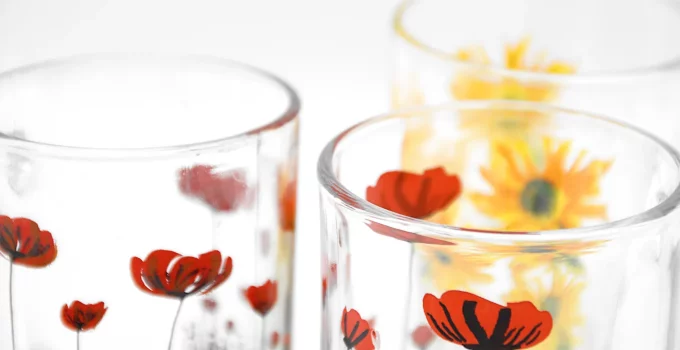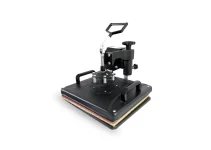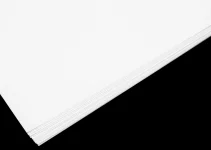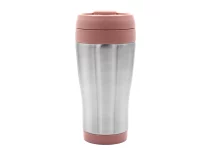Answering the question can you sublimate on glass can seem easy at first glance because the direct answer is that we can sublimate on glass.
Just like we can sublimate on acrylic, ceramic mugs, mylar bags, polyester t-shirts, etc. There are plenty of materials we can sublimate on.
On the other hand, when I wrote an article discussing whether we can sublimate on rayon, the answer was not as straightforward.
However, in principle, we should all know that we can sublimate on glass because it has a high heat resistance. So that part is easy to figure out. We definitely don’t have to worry about anything happening when we need to heat transfer our designs from the sublimate paper to the glass surface.
Can You Sublimate on Glass? Does Regular Glass Work?
There is one thing we must define more clearly.
Can we sublimate on regular pieces of glass or on regular frosted glass or any drinking glasses, regular glass can tumblers, etc.?
The truth is that we need to look for glass for sublimation because only this type will come with a sublimation coating. The coating is ready to absorb our design when heat is used to transfer it from the paper onto our various glass surfaces.
Thus, if we want to create art on a sheet of glass, like a photo frame created by us, we generally need to look for sublimation blank glass cutting boards or for sublimation glass photo frames.
If we want to personalize glass can tumblers or drinking glasses or shot glasses, the same applies. We need to look for sublimation glass tumblers, etc.
The situation would be the same if we wanted to sublimate stainless steel tumblers, in case glass can tumblers are too fragile for you. We would need to buy sublimation blank stainless steel tumbler cups.
Another object we can personalize is a sublimation fridge magnet blank.
There are certainly different glass shapes, objects, and sizes that we can sublimate on if they have a sublimation coating.
Overall, the idea is that the full answer to the question can you sublimate on glass is yes, but it needs to be glass ready for sublimation, glass with a poly coating.
If you can’t buy glass pieces that are already prepared for sublimation, we can consider buying our own poly coating for hard surfaces, like glass, wood, ceramic, metal, etc.
With this poly coating, we can prepare pieces of regular glass for sublimation.
Sublimation coating for regular glass
If you can’t buy glass blank sheets, glass can tumblers, blank fridge magnets, etc. for sublimation, objects that already come with the needed coating, then we can apply our own coating on whatever surfaces we want.
One of my favorites is the Dyepress PolyGloss sublimation coating for hard substrates.
You can find a lot more info on their website but I’m going to write a short introduction on it.
It’s a great product if you want to prepare a variety of objects for sublimation. It will create a glossy finish.
The materials we can use it on are:
metal (stainless steel mugs, aluminum products, fridge magnets, aluminum water bottles, Zippo lighters, keychains, etc.)
glass
wood
ceramic mugs & tile
polished marble & stone
hardboard
FRP (fiberglass reinforced plastic)
The Dyepress PolyGloss is a 2-part, high-gloss, water-based sublimation coating. It’s a polyester resin that is easily applied and it cleans up easily with water.
There are also multiple quantities to choose from: 16 oz, 32 oz, 64 oz, 1 gallon, and 5 gallons.
Instructions
I recommend watching this YouTube tutorial if you want some visual instructions besides these written ones.
We get two bottles: Poly and a small bottle of catalyst.
We need to add 1 ml of catalyst per ounce of Poly and stir thoroughly.
Prepare your hard surface, in our case the glass object we want to sublimate on, with rubbing alcohol. For metal, we need to clean it with a solvent like Xylol.
Get a brush and apply one thin coat of PolyGloss mixture. It’s important for this coat to be thin.
If it’s too thick, the paper will stick and the image will look mushy.
We also need to apply in an environment with a min temp of 60 degrees F and a min humidity of 30%.
Once the thin coat is applied, we need to let it dry. Slow drying, taking around 2-3 hours, is best.
It needs humidity to give the bubbles time to pop before the coating starts to dry.
Once dry, cure the substrate in the oven at 340 degrees F for 22 minutes or in a convection oven at 300 degrees F for 22 minutes.
Overall, the Dyepress PolyGloss sublimation coating for hard substrates is not a cheap product but it will work really well for sublimation.
I consider it an integral part of our answer to the question can you sublimate on glass. It’s a good solution for those who can’t or don’t want to buy products that are already ready for sublimation.
How to sublimate on glass: What we need
Now that we’ve resolved the question of what type of glass we need or what coating to use if you want to experiment on regular glass, it’s time to talk about what other tools we need for our sublimating on glass guide.
Sublimation printer
We can’t sublimate without the trifecta: sublimation printer, sublimation paper, and sublimation inks.
When it comes to buying our printer, there are two options to choose from. If you want to learn more about these two options, check out my recommendations for the best sublimation printer for beginners.
We can either buy a dedicated dye-sublimation printer, which is totally awesome but it can also cost quite a lot. These are models like the Sawgrass SG500, Sawgrass SG1000, Epson SureColor F170, Epson SureColor F570, etc. They can be awesome, the models from Sawgrass have a really high resolution. But they can also be quite expensive.
The alternative is to convert piezo inkjet printers, mostly printers from Epson, to sublimation.
The conversion is done by buying sublimation inks for the respective Epson model and using those special dyes to fill in the ink tanks. Don’t use the ink that comes with the inkjet printer because those are meant for regular printing.
To give you some examples of models that can be converted, we have the Epson EcoTank ET-4700, Epson EcoTank ET-2803, Epson EcoTank ET-15000, Epson WorkForce WF-7720, and many others.
Conversion can be awesome and even some small business owners prefer buying inkjet printers and then converting them. They’re very popular and they can work beautifully.
Graphic design software
If we want to create our own personalized designs, then you have to use graphic design software and apps.
These can be free like GIMP and Canva. They’re both awesome both for professionals and for amateurs.
Or we can use software like Photoshop, Adobe Illustrator, Gravit, Affinity, and Sawgrass Creative Studio.
Heat press
The thing is that there are two main types of glass objects we can sublimate on:
- blank sheets of glass, which are flat like photo frames or cutting boards
- and round glass objects, like glass can tumblers, glass jars, drinking glasses or shot glasses, etc.
Why did I mention these two different shapes, a flat one and a round one? Because we need different heat presses depending on the shape of our products.
So, if we want to sublimate on both flat and round objects, we’ll need to buy two different heat presses, which will increase our expenditure but that’s how it is.
If we’re doing blank sheets of glass we need a heat press machine, like the kind we use for t-shirts, acrylic sheets, keychains, fridge magnets, etc.
Some heat press machines will also come with different accessories, like mug press and hat press.
In that case, you don’t need to buy a separate tumbler heat press machine., like the Cricut Mug Press for mugs.
The Cricut Mug Press works well for mugs but it won’t do for slimmer objects, like tumblers, jars, etc.
For slimmer objects, you need something like the Pokovici Tumbler Heat Press Machine.
If your heat press doesn’t come with a mug press accessory but you want to sublimate on tumblers, cups, mugs, jars, etc., then you need to buy a separate tumbler heat press machine that will press our design on all kinds of round objects, whether they’re made of ceramic, glass, metal, etc.
The other option is to transfer the design by using a convection oven instead of a heat press.
Butcher paper
Once we have the heat press we desire based on the shape of the glass objects we need to sublimate on, the other thing we need for the heat press is butcher paper.
The paper will cover both the top and bottom heat plates. Or it will envelope the round object in the case of a tumbler heat press.
We absolutely have to use butcher paper every time we sublimate. When heated, the ink turns into gas. Butcher paper locks it in, preventing the images from being fuzzy.
And it prevents ink from getting all over our heat plates. Cleaning those is not fun.
Other people prefer using protective paper, like the Artesprix Protective Paper. But butcher paper remains the most popular option to protect both the heat press and our designs.
Another alternative is using regular copy paper. Maybe use it in two-three layers to ensure better heat protection. And make sure to cover the entire object that you want to sublimate on.
Of course, we don’t use butcher paper if we use a convection oven instead of a heat press.
Heat resistant tape
We use heat resistant tape to secure the sublimation paper, which has the design printed on it, to our glass object that we want to transfer the design onto via our heat press.
It’s a great idea to use heat resistant tape if you want to make sure that your paper stays fixed onto your glass object.
Heat resistant gloves
The glass object and the sublimation paper still attached to it via the heat resistant tape are removed immediately as soon as the timer on your heat press is done.
The image will have been transferred onto your glass surface so the design can’t be removed now even after multiple washes.
With the heat resistant gloves, peel off the sublimation paper to reveal your new and beautifully personalized glass object.
Overall, including all this equipment is absolutely part of answering the question: can you sublimate on glass? It’s good to know what you should expect and what you should prepare beforehand.
How to Sublimate on Glass in 5 Steps
The rules are pretty similar whether we’re doing glass sheet blanks, like a photo frame or a glass cutting board, or whether we’re sublimating on glass tumblers, jars, cups, etc.
As I’ve mentioned, the shape of our glass objects mainly influences which type of heat press we’re using.
Once again, if you sublimate on round objects, the Cricut Mug Press can be a good heat press that also has a pretty decent price but it mostly works for mugs.
For tumblers and jars, you need a tumbler heat press like the PYD Life 2 in 1 Tumbler Heat Press Machine. Generally, tumbler heat presses are very expensive so you need to consider seriously if these are the objects you absolutely want to sublimate on.
If you want a small heat press for t-shirts, tote bags, pillows, mylar bags, aprons, then we have the Cricut EasyPress 2 Heat Press Machine. It’s a 9 x 9 heat press so it’s great for those using a sublimation printer with 8.5 (8.5 x 14 inches sublimation paper) max print size.
For bigger objects, we have the Fancierstudio Digital Heat Press, it’s a 15 x 15 so it’s great for bigger t-shirts that are printed with 13 x 19 sublimation printers.
Step 1. Print your design
Of course, the first step is to print our design. We can download free designs. Or we can create our personal own from pictures we take or what other people want printed. Or we can create various designs with the help of various graphic design software. The options are endless.
Of course, we use sublimation inks to print on sublimation paper. These are crucial components.
Step 2. Mirror images for sublimation on glass
We don’t need to mirror images in all cases.
Just like it was the case with acrylic sheets, we don’t need to mirror the image if we sublimate on blank glass sheets where the design is put on the back.
If we transfer the image from the paper to the glass sheet blank and we put the image on the back, then we don’t need to mirror.
That means that the poly coating is on the back.
On the other hand, if the sublimation coating is on the front, then we need to mirror images.
Sublimation tumblers require a mirrored image of the design. The same goes for jars, mugs, etc.
Step 3. Clean your glass surface
It’s important to obviously imprint our designs on a completely clean glass surface.
You can use rubbing alcohol and then press the sublimation paper on it when it’s completely dry. It will evaporate quickly.
Other people prefer using a lint roller, which is actually a pretty innovative idea.
Step 4. Placing the sublimation paper
If you buy sublimation glass objects, the poly coating looks like a white coating. If you print on photo frames or glass cutting boards for sublimation, the coating is on the back.
Of course, tumblers and mugs are coated on their exterior. And remember that we need to mirror images for these round objects.
For glass sheets, place your sublimation paper with the design on your work surface. Then take the glass and place it with the coating on top of the paper. The side that is not coated will be the one that lands on top untouched.
For tumblers and jars, wrap the sublimation paper with the design touching the glass objects. The blank of the paper is the one facing us.
Make the paper stick with the help of heat resistant tape. Use as much tape as you need until the paper is completely immobile and sticks to the glass surface completely.
Step 5. Use the heat press
This is the step for which we need to use heat resistant gloves.
For the tumbler heat press, wrap up the round glass object in butcher paper or protective paper. Then place it in the tumbler heat press at 356 degrees F for 120 seconds.
Flip it then press again. In total, we need 240 seconds to do the entire circumference.
For glass sheet blanks, place the sheet with the top down. Thus, staring at you should be the blank side of the paper.
Don’t forget about covering the heat plates, both on the top and on the bottom, with butcher paper.
The heat press can be set up at 365 degrees F for 360 seconds.
However, each glass piece might come with its own temp and time recommendations so make sure to check that out.
Remove your objects from the heat press as soon as it’s done. Remove the paper and that’s it.
All in all, answering the question can you sublimate on glass is yes but, as you saw, there are many other details we needed to include for this guide and I hope it’s helpful.




